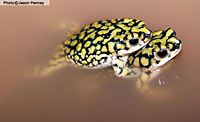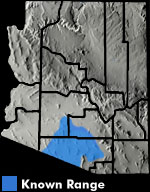Online Field Guide to The Reptiles and Amphibians of Arizona



Pima County, AZ
 Pima Co., AZ |
| SONORAN GREEN TOAD Anaxyrus retiformis | |
|
DESCRIPTION: Adult Sonoran green toads reach a length of 1.5-1.9 inches in males, and 1.8-2.3 inches in females. The cranial crests are reduced or absent, but the parotoid glands are large and elongate, and are widest at a point approximately 1/3 back from the anterior edge. Warts on the parotoid glands are reduced and black tipped. The dorsal coloration of this animal is a dramatic black or brown reticulation surrounding oval, or circular areas of green, greenish-yellow, or yellow. Males have a dark throat (females have a cream or white throat). The tadpoles are similar to those of the Green toad and likely grow to about one inch prior to metamorphosis. DISTRIBUTION: Occurs from the Vekol Valley and Mobile east to the Altar Valley and San Xavier Mission and south through the Tohono O’odham Reservation and central Sonora to at least Hermosillo, but possibly as far south as Navojoa. HABITAT: In Arizona, this species occurs in valleys and sparingly onto the lower bajadas, where it is typically found in lower Colorado River and Arizona upland subdivisions of Sonoran Desertscrub, but also in semi-desert grasslands that have been invaded by mesquite and other desert trees, shrubs, and cacti (Altar Valley). Within these vegetation communities, Sonoran green toads frequent cattle tanks and other impoundments, places where water accumulates in large arroyos, roadside ditches, and mesquite thickets. Rangewide, the species occurs at elevations of 500 to 1500 feet. BEHAVIOR: Similar to other monsoon breeding anurans, the Sonoran green toad spends most of its life underground awaiting the summer rains. They have lived more than 17 years in captivity. REPRODUCTION AND CALLS: This is an “explosive” breeder that emerges from aestivation and moves to breeding ponds during or after the first substantial monsoon storm. Breeding occurs generally for 1-3 nights at ephemeral rain pools (including cattle tanks). Males call at nightfall, usually from grassy areas 3-16 feet from the waters edge. Amplexus is initiated on land – the larger female carries the male to water. The call is an insect-like buzz lasting 2.0-4.3 seconds that is very similar to the call of the Green toad and Great Plains narrow-mouthed toad. Eggs are laid singly or in small clumps; clutches range from 5-200 eggs. The eggs hatch in 2-3 days and tadpoles metamorphose 2-3 weeks after hatching. DIET: The feeding habits of the Sonoran green toad have not been investigated, but it likely feeds upon a variety of invertebrates, such as winged termites, ants, moths, and beetles. REMARKS: Sonoran green toads hybridize with Red-spotted toads at some localities in Arizona. Hybridization with the Little Mexican toad (Anaxyrus kelloggi) in Sonora obscures the southern extent of the Sonoran green toad’s distribution. The Sonoran green toad may be more abundant or could have expanded its range in Arizona because of surface disturbances such as cattle tanks and other impoundments, and places along roads and railroad tracks that collect water in which this species breeds. By Ernest Nigro and Jim Rorabaugh Blomquist, S.M. 2005. Bufo retiformis Sanders and Smith 1951 Sonoran green toad. Pages 433-435 in M.J. Lannoo (ed), Amphibian Declines: The Conservation Status of United States Species. University of California Press, Berkeley, CA. Brennan, T.C., & Holycross, A.T. 2006. A Field Guide to the Amphibians and Reptiles in Arizona. Arizona Game and Fish Department. Phoenix, AZ. Enderson, E.F., and R.L. Bezy. 2007. Amphibians of Vekol Valley. Pages 338-342 in R. Felger and B. Broyles, eds., Dry Borders, Great Natural Reserves of the Sonoran Desert. University of Utah Press, Salt Lake City, UT. Hulse, A.C. 1978. Bufo retiformis. Catalogue of American Amphibians and Reptiles. (207):1-2. Sullivan, B.K., R.W. Bowker, K.B. Malmos and E.W.A. Gergus. 1996. Arizona distribution of three Sonoran Desert anurans: Bufo retiformis, Gastrophryne olivacea, and Pternohyla fodiens. Great Basin Naturalist. 56 (1):38-47. |
|
Visit Partners in Amphibian and Reptile Conservation:


HOME
Copyright © 2023, Arizona Game and Fish Department. All rights reserved.
If you make use of the textual contents of this site in reports, publications, etc. please cite and credit the author(s) and photographer(s). All photos on this website are copyrighted. However, those found in the species account section may be used for any noncommercial scientific, educational, or conservation purposes provided that photographs are not altered and continue to bear the copyright symbol and name of the photographer. Please contact the photographer regarding commercial use of copyrighted photographs.











